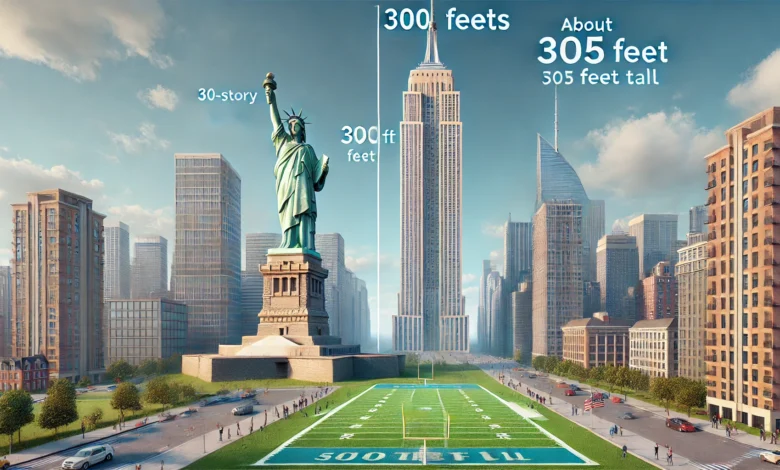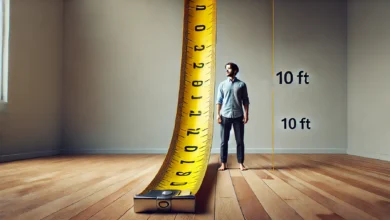How Tall is 300 Feet? A Real-World Comparison Guide

When someone asks, “how tall is 300 feet?” the answer may sound simple: 300 feet equals 91.44 meters. But what does that actually look like in real life? Unless you’re an engineer, architect, or someone who measures height for a living, it can be hard to visualize such a large number. That’s why breaking it down with real-world comparisons is the best way to truly understand how tall 300 feet really is.
In this article, we’ll dive deep into the measurement of 300 feet, compare it with famous landmarks, explain it in everyday scenarios, and give you plenty of examples so you can instantly picture the scale. By the end, you won’t just know the number—you’ll feel the size of it.
Understanding the Measurement of 300 Feet
Before we start comparing, let’s get the basics right. Three hundred feet equals:
- 91.44 meters (in metric units)
- 3,600 inches
- 100 yards (about the length of a football field)
That alone should give you a starting point. Imagine standing at one end of an American football field and looking all the way to the other side. That length turned vertically is roughly how tall 300 feet is.
But while a football field comparison helps, it still feels abstract to most people. After all, we don’t go around stacking football fields on top of each other in daily life. So, to put 300 feet into perspective, let’s look at objects and structures you already know.
How Tall is 300 Feet Compared to Buildings?
The easiest way to picture 300 feet is by thinking of tall buildings. Skyscrapers vary in height, but the average floor in a commercial building is about 10 to 12 feet tall.
That means:
- 300 feet = about 25 to 30 floors in a building.
If you’ve ever seen a 25-story office building in a city skyline, that’s approximately how tall 300 feet is. Not exactly a skyscraper like the Empire State Building (which is 1,454 feet including its antenna), but tall enough to dominate the view in a smaller city.
For comparison:
- The Statue of Liberty (from base to torch) is about 305 feet tall.
- A 30-story apartment building is usually right around 300 feet.
- The Big Ben clock tower in London is about 316 feet tall.
So, if you’re wondering “how tall is 300 feet,” just think about standing at the base of the Statue of Liberty and looking up. That’s the answer in its most iconic form.
Natural Comparisons: Trees, Cliffs, and Mountains
Not all height comparisons need skyscrapers. Nature gives us plenty of examples too.
For instance:
- A redwood tree in California can easily reach 300 feet, making it one of the tallest living organisms on Earth.
- Many waterfalls, like the famous Snoqualmie Falls in Washington (268 feet), are just shy of 300 feet.
- Cliffs and bluffs along the ocean coastlines often rise about 300 feet above sea level.
Imagine hiking and standing at the edge of a cliff that drops straight down 300 feet. That’s a long way down—it’s the kind of height where you’d definitely think twice before peeking over the edge.
Mountains, of course, are much taller, but smaller peaks or hills you may have driven past often reach about 300 feet. So in nature, 300 feet is impressive but not unimaginable—it’s something you can encounter in a giant tree, a cliffside, or a waterfall.
How Tall is 300 Feet Compared to Everyday Objects?
Sometimes, it’s easiest to understand height by looking at everyday things you already recognize. Here’s a breakdown:
- Telephone poles are usually around 30 to 40 feet. So, 300 feet would equal about 8–10 telephone poles stacked on top of each other.
- School buses are about 35 feet long. If you parked them bumper to bumper and then stood them upright, it would take around 9 school buses to reach 300 feet.
- Basketball hoops are 10 feet tall. So, picture 30 basketball hoops stacked one on top of the other.
These kinds of comparisons make it easier to say, “Wow, 300 feet is actually much taller than I thought.”
Aviation Perspective: How Tall is 300 Feet in the Sky?
If you’ve ever flown on an airplane, you know how quickly altitude changes your perception of distance. While cruising at 30,000 feet doesn’t allow you to notice much about 300 feet, during takeoff and landing, it’s a different story.
At about 300 feet in the air, a plane is just seconds from touching down on the runway. For pilots, this is the height where they need to make precise decisions, because they’re so close to the ground.
To put it in perspective, standing at 300 feet above the ground gives you a commanding view of your surroundings. Imagine being on a rooftop terrace of a 25-story building—you’d easily see over a large city, far beyond what you could see at ground level.
Sports Comparisons: Stadiums and Fields
Sports fans often have a good sense of distance when it comes to fields and stadiums. For example:
- In baseball, the distance from home plate to the outfield fence is often around 300 feet. So if you’ve watched a home run fly into the stands, you’ve literally seen what 300 feet looks like stretched horizontally.
- In football, as mentioned earlier, 300 feet is the same length as a football field (100 yards). Now imagine turning that field upright—that’s the height we’re talking about.
This comparison is helpful because sports fans can visualize the distances instantly—they’ve seen them hundreds of times.
Fun Comparisons to Visualize 300 Feet
Sometimes it helps to get playful with the comparisons. Let’s break it down in fun, unusual ways:
- About half the height of the Eiffel Tower (1,083 feet tall).
- Roughly the same as a blue whale stacked end to end six times.
- About three Boeing 737 airplanes placed nose to tail vertically.
- Close to 20 giraffes standing on top of one another.
These fun visuals stick in your brain, making it easier to recall how tall 300 feet is without needing to think in numbers.
Why Understanding “How Tall is 300 Feet” Matters
You might wonder, why does it even matter to know how tall 300 feet is? Well, understanding scale and size is important in many aspects of life.
For one, it helps when traveling—whether you’re looking at landmarks, exploring cities, or hiking in nature. Architects, engineers, and construction workers constantly work with these measurements, so being able to visualize them makes planning easier.
It also matters in storytelling and communication. For instance, if a journalist writes about a “300-foot cliff,” readers need to picture it correctly. If you’re explaining something to a friend or teaching kids about size, comparisons like this make learning fun and memorable.
And let’s be honest—sometimes it’s just fascinating to realize how tall certain things are. The next time someone casually mentions a height of 300 feet, you’ll instantly have a mental image to compare it to.
Final Thoughts: So, How Tall is 300 Feet Really?
At the end of the day, 300 feet is taller than most buildings in a city, as tall as the Statue of Liberty, and about the height of some of the tallest trees on Earth. It’s the kind of measurement that feels abstract until you see it in action—but once you compare it to landmarks, buildings, and everyday objects, it becomes much easier to picture.
So the next time you ask yourself, “how tall is 300 feet?” just imagine standing at the foot of the Statue of Liberty, looking up at her torch, or walking the length of a football field—only this time, straight into the sky. That’s 300 feet in real, breathtaking scale.

